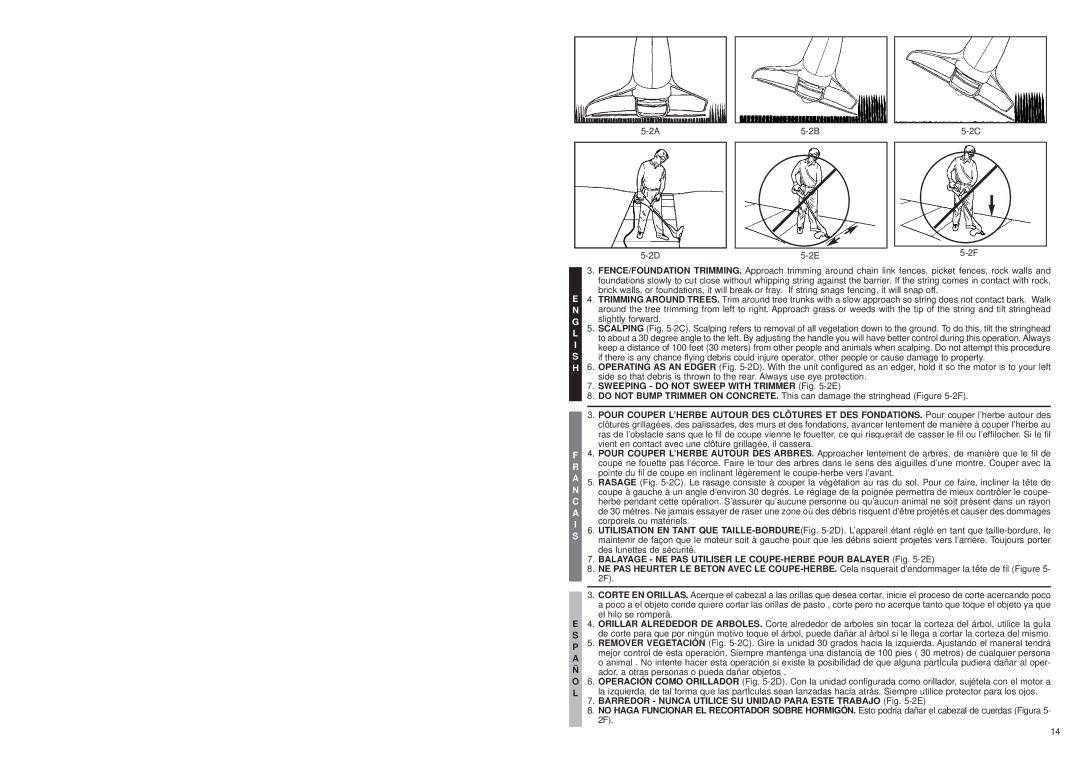
|
| ||||
|
|
|
|
|
|
|
|
|
|
|
|
|
|
|
|
|
|
|
|
|
|
|
|
|
|
|
|
|
|
|
| ||
| |||
|
|
|
3.FENCE/FOUNDATION TRIMMING. Approach trimming around chain link fences, picket fences, rock walls and foundations slowly to cut close without whipping string against the barrier. If the string comes in contact with rock,
brick walls, or foundations, it will break or fray. If string snags fencing, it will snap off.
E4. TRIMMING AROUND TREES. Trim around tree trunks with a slow approach so string does not contact bark. Walk N around the tree trimming from left to right. Approach grass or weeds with the tip of the string and tilt stringhead
G | slightly forward. |
5. SCALPING (Fig. | |
L | to about a 30 degree angle to the left. By adjusting the handle you will have better control during this operation. Always |
Ikeep a distance of 100 feet (30 meters) from other people and animals when scalping. Do not attempt this procedure S if there is any chance flying debris could injure operator, other people or cause damage to property.
H 6. OPERATING AS AN EDGER (Fig.
7.SWEEPING - DO NOT SWEEP WITH TRIMMER (Fig. 5-2E)
8.DO NOT BUMP TRIMMER ON CONCRETE. This can damage the stringhead (Figure
3.POUR COUPER L’HERBE AUTOUR DES CLÔTURES ET DES FONDATIONS. Pour couper l’herbe autour des
clôtures grillagées, des palissades, des murs et des fondations, avancer lentement de manière à couper l’herbe au ras de l’obstacle sans que le fil de coupe vienne le fouetter, ce qui risquerait de casser le fil ou l’effilocher. Si le fil vient en contact avec une clôture grillagée, il cassera.
F4. POUR COUPER L’HERBE AUTOUR DES ARBRES. Approacher lentement de arbres, de manière que le fil de
R | coupe ne fouette pas l’écorce. Faire le tour des arbres dans le sens des aiguilles d’une montre. Couper avec la | |
pointe du fil de coupe en inclinant légèrement le | ||
A | ||
5. RASAGE (Fig. |
Ncoupe à gauche à un angle d’environ 30 degrés. Le réglage de la poignée permettra de mieux contrôler le coupe- C herbe pendant cette opération. S’assurer qu’aucune personne ou qu’aucun animal ne soit présent dans un rayon
Ade 30 mètres. Ne jamais essayer de raser une zone où des débris risquent d’être projetés et causer des dommages
Icorporels ou matériels.
6.UTILISATION EN TANT QUE
des lunettes de sécurité.
7. BALAYAGE - NE PAS UTILISER LE COUPE-HERBE POUR BALAYER (Fig. 5-2E)
8. NE PAS HEURTER LE BETON AVEC LE
3.CORTE EN ORILLAS. Acerque el cabezal a las orillas que desea cortar, inicie el proceso de corte acercando poco a poco a el objeto conde quiere cortar las orillas de pasto , corte pero no acerque tanto que toque el objeto ya que el hilo se romperá.
E4. ORILLAR ALREDEDOR DE ARBOLES. Corte alrededor de arboles sin tocar la corteza del árbol, utilice la guÌa
Sde corte para que por ningún motivo toque el árbol, puede dañar al árbol si le llega a cortar la corteza del mismo.
P | 5. REMOVER VEGETACIÓN (Fig. |
| mejor control de esta operación. Siempre mantenga una distancia de 100 pies ( 30 metros) de cualquier persona |
A | o animal . No intente hacer esta operación si existe la posibilidad de que alguna partÌcula pudiera dañar al oper- |
Ñador, a otras personas o pueda dañar objetos .
O6. OPERACIÓN COMO ORILLADOR (Fig.
Lla izquierda, de tal forma que las partÌculas sean lanzadas hacia atrás. Siempre utilice protector para los ojos.
7.BARREDOR - NUNCA UTILICE SU UNIDAD PARA ESTE TRABAJO (Fig.
8.NO HAGA FUNCIONAR EL RECORTADOR SOBRE HORMIGÓN. Esto podría dañar el cabezal de cuerdas (Figura 5- 2F).
14
